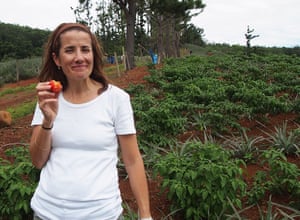
Up to 87% of undamaged, edible tomatoes harvested from a commercial Queensland farm were rejected and wasted based on appearance, a study has found, highlighting the problem of food wastage.
Tara McKenzie, an environmental scientist at the University of the Sunshine Coast, said that at every point in the supply chain, edible tomatoes that were slightly odd-shaped or marked or deemed too small or too large were rejected because they didn’t meet market standards for premium, unblemished product. She found between 68.6% and 86.7% of the produce was rejected.
The government estimates food waste costs the Australian economy $20bn each year.
Researchers examined a farm in Bundaberg that had two separate supply chains running to provide tomatoes to markets in Bundaberg and Brisbane. Led by McKenzie, they followed the tomatoes from the point of harvesting through to sorting and handling, transport, and storage.
The farm chosen had an annual pack volume of 4,500 tonnes, and interviews were conducted with farmers and workers along the supply chain to evaluate how decisions were made to reject tomatoes. The study did not examine preharvest losses or consumer waste.
The research also found that between 70% and 84% of tomatoes grown were left in the field, because the cost of harvesting and supplying them to market was greater than any profit to be made.
A co-author of the paper published in the journal Horticulturae, Dr Lila Singh-Peterson, said while supermarkets were partly responsible for demanding unblemished products, the policies of supermarkets were probably reflecting consumer expectations.
“But the standards supermarkets impose on farmers are very stringent, and the farms have to meet those standards or the supermarkets will just choose another supplier,” Singh-Peterson said.
“The waste is ridiculous. Regulation needs to occur at the market end so that rather than having supermarkets dictating contracts with farmers, the regulation should occur through a central market.”
She added that government support for farmers was woeful. About 4% of Australian farm income could be traced back to government support, she said, compared to 61% in Norway and 52% in South Korea.
“We’ve really abandoned farmers and just expect them to cope with extra market pressures,” she said.
The study reported on interviews with staff along the supply chain. One field manager told the researchers: “The size we pick depends on the days’ price … if the price is a little bit high, the market wants the small tomatoes as well. Otherwise, if the price is low … we do not pick the small stuff”. Someone else commented that supermarket standards expected fresh produce to “conform like a packet of Arnott’s biscuits”.

Bundaberg Fruit and Vegetable Growers cooperated with the researchers and allowed them to follow the supply chain. The organisation’s managing director, Bree Grima, said tomatoes grown in the field as those in the study were would always result in a higher level of waste than those grown in protected cropping situations.
But the level of waste was nonetheless high, and was an issue growers had long been concerned about, she said.
“A range of things contribute to produce being rejected including shape, size, rub marks and insect activity,” she said. “All we can do is continue to put pressure on supermarkets and show that we are at risk of leaving the industry and indeed, already a lot of us have as growers simply cannot make ends meet. We continue to have the pressure put on us from higher above and we have nowhere to go.
“We want a fair price for produce and we need to create consumer awareness so people know that if they see tomatoes for two dollars per kilo, everyone involved in supplying the product is taking a cut of that and people need to think about what that means for the farmer.”
The study concluded that post-harvest loss was due to “deliberate and informed actions of supply chain actors, dictated predominantly by private food standards and market value rather than a lack of access to appropriate postharvest handling infrastructure”.
“Stringent product specifications enforced via private food standards due to the combination of asymmetric supermarket business practices and consumer purchasing behaviour are considered by the supply chain actors to be the fundamental cause of high food loss and waste,” the study found.
“Given the notable lack of research on food loss and waste in developed countries, the results of this paper necessitate a greater research effort, particularly at the production end of the food supply chain.”
No comments:
Post a Comment